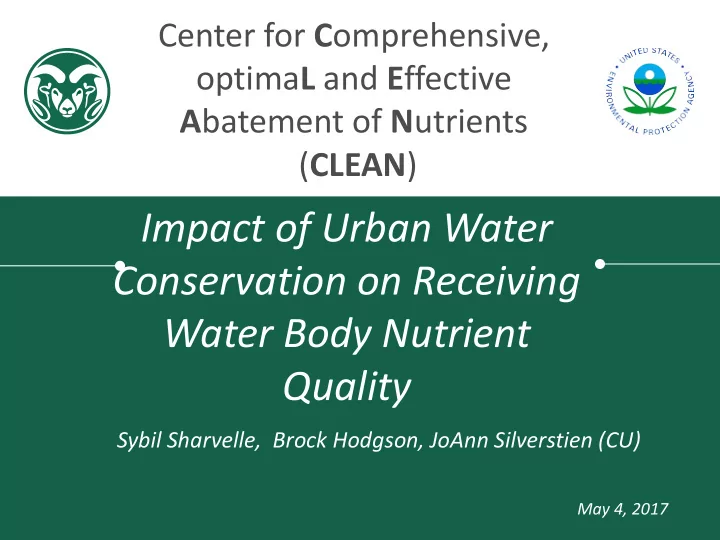

Center for C omprehensive, optima L and E ffective A batement of N utrients ( CLEAN ) Impact of Urban Water Conservation on Receiving Water Body Nutrient Quality Sybil Sharvelle, Brock Hodgson, JoAnn Silverstien (CU) May 4, 2017
The CLEAN Center EPA Centers for Water Research on National Priorities Related to a Systems View of Nutrient Management o Established in 2013 o One of 4 national centers o The only center with irrigated agriculture components
Mission of CLEAN Create knowledge Build capacity Forge collaboration To develop and demonstrate sustainable solutions for reduction of nutrient pollution
Water Demand Reduction Indoor and Graywater Stormwater Effluent Reuse Outdoor Reuse Use Conservation
Water Conservation Impacts No Conservation Conservation Water Water Demand Demand Nutrient Nutrient Wastewater Wastewater Load Load Result is more concentrated wastewater
Boulder 75 th St WWTF Case Study • 75 th St WWTF serves Boulder, CO • Permitted capacity = 25 MGD Source: https://bouldercolorado.gov/water/wastewater-treatment • Average operating flow = 20 15.2 MGD (Reg. 85 Data) 18 16 • Biological Nutrient Removal 14 Concentration (mg/L) – 4 Stage Bardenpho 12 10 8 6 4 2 0 EFF-TIN mg/L - N EFF-TN mg/L - N EFF-TP mg/L - P Source: Regulation 85 Reported Data n = 12
Approach Reg. 85 Flow Reg. 85 Data Baseline Baseline Influent Effluent Influent Concentration Baseline Removal Rate IUWM Modeling Impact on Strategy Influent BioWin Modeling Impact on Removal Effluent Upstream Downstream Reg. 85 Data
Modeling Approach • BioWin modeling of WWTP’s for source control, reuse and conservation scenarios – Indoor Conservation • 15-54% flow reduction • Constant contaminant loading – Urine Separation • 5%, 15%, 30%, 75% and 100% population adoption – Flow change = 10 gallons/person/day • Loading adjusted assuming 11 g N/person/day and 1 g P/person/day – Graywater Reuse • 5%, 15%, 30%, 75% and 100% population adoption – Toilets: 12 gallons/person/day – Irrigation: 25 gallons/person/day • Loading adjusted according to literature estimates
Impact of Practice to WW Influent Quality 50 16 45 14 40 12 35 Concentration (mg/L) 10 30 Flow (MGD) 25 8 TKN (mg/L - N) TP (mg/L - P) 20 Flow (MGD) 6 15 4 10 2 5 0 0 Baseline Conservation - 23% Source Separation - Graywater Toilet Reuse Graywater Irrigation Indoor Conservation 26% Population - 26% Population Reuse - 26% Adoption Adoption Population Adoption
Effluent TIN normalized concentration ratio 3.5 Effluent TIN ratio (Conservation/Base) Boulder 3.0 Longmont 2.5 Metro 2.0 Regression 1.5 1.0 0.5 0.0 0% 10% 20% 30% 40% 50% 60% Indoor conservation: influent flow reduction
Approach Reg. 85 Flow Reg. 85 Data Baseline Baseline Influent Effluent Influent Concentration Baseline Removal Rate IUWM Modeling Impact on Strategy Influent BioWin Modeling Impact on Removal Effluent Upstream Downstream Reg. 85 Data
Impact of Practices on Effluent Discharge Source Separation Conservation 30 250 16 250 25 14 200 200 CEFF (mg/L-N or P) LEFF (lbpd -N or P) CEFF (mg/L-N or P) LEFF (lbpd -N or P) 12 20 150 10 150 15 8 100 100 6 10 4 50 50 5 2 0 0 0 0 0% 20% 40% 60% 80% 100% 0% 20% 40% 60% Percent Population Adopting Technology (%) Percent Aditional Indoor Conservation (%) Effluent TN Conc. Effluent TP Conc. Graywater Irrigation Effluent TN Load Effluent TP Load 20 250 18 200 16 CEFF (mg/L-N or P) LEFF (lbpd -N or P) • Conservation practices result in 14 150 12 increase in nutrient discharge 10 100 8 concentration 6 4 50 2 • Source separation decreases 0 0 0% 20% 40% 60% 80% 100% effluent discharge Percent Population Adopting Technology (%)
Impact of Practices on Downstream Concentration Conservation Source Separation 6 3000 6 2500 5 2500 5 2000 CDS (mg/L - N) LEFF (lbpd - N) CDS (mg/L - N) LEFF (lbpd - N) 4 2000 4 1500 3 1500 3 1000 2 1000 2 500 1 500 1 0 0 0 0 0% 20% 40% 60% 0% 50% 100% Percent Additional Indoor Conservation (%) Percent Population Adopting Technology (%) Downstream TN Concentration Effluent TN Load Downstream TN Concentration Effluent TN Load Graywater Irrigation WWTP Effluent Reuse 6 2500 6 3000 5 5 2500 2000 LEFF (lbpd - N) LEFF (lbpd - N) CDS (mg/L - N) CDS (mg/L - N) 4 4 2000 1500 3 3 1500 1000 2 2 1000 500 1 500 1 0 0 0 0 0% 50% 100% 0% 20% 40% Percent of Effluent Reused (%) Percent Population Adopting Technology (%) Downstream TN Concentration Effluent TN Load Downstream TN Concentration Effluent TN Load Bars indicate min and max
Conservation Impact: P 30 250 CEFF (mg/L-N or P) LEFF (lbpd -N or P) • Effluent 25 200 20 150 concentration 15 100 10 50 increases, but load 5 0 0 0% 20% 40% 60% does not Percent Aditional Indoor Conservation (%) substantially change Effluent TN Conc. Effluent TP Conc. Effluent TN Load Effluent TP Load Conserved flow removed from system Conserved flow stays in stream 450 1.6 450 1.4 400 400 1.4 1.2 350 350 1.2 LEFF (lbpd - P) LEFF (lbpd - P) CDS (mg/L - P) CDS (mg/L - P) 1.0 300 300 1.0 250 250 0.8 0.8 200 200 0.6 0.6 150 150 0.4 0.4 100 100 0.2 0.2 50 50 0.0 0 0.0 0 0% 20% 40% 60% 0% 20% 40% 60% Percent Additional Indoor Conservation (%) Percent Additional Indoor Conservation (%) Downstream TP Concentration Effluent TP Load Downstream TP Concentration Effluent TP Load
Summary • Conservation can increase effluent discharge concentrations, especially nitrogen species – Minimal impact to nutrient mass loads – Impact to downstream concentrations depends on surface water flow and mixing zone characteristics • Municipalities encouraging conservation will need to consider impacts to POTW performance/operations • Potential Utility Costs: – Energy costs of increasing SRT and aeration rate – Greater impact of sidestream (centrate) nutrients – Chemical addition for pH control – Labor and materials for increased sewer maintenance
Thank you. To join stakeholder group: Theresa.Connor@colostate.edu
Recommend
More recommend